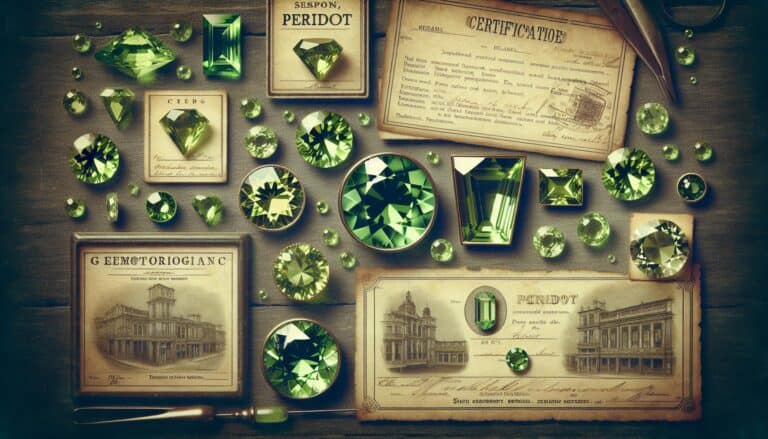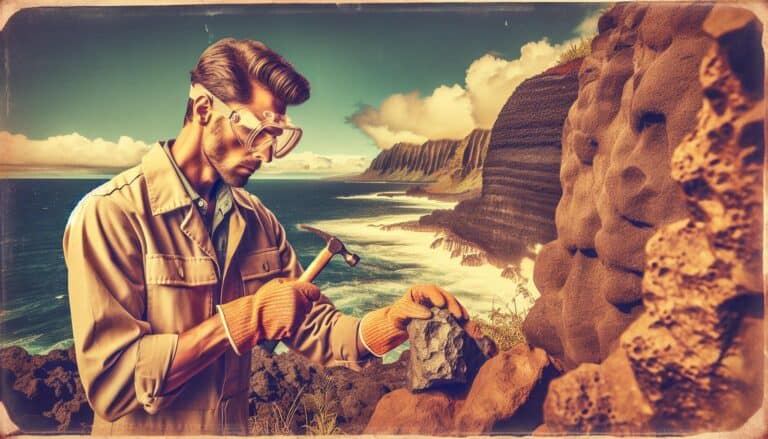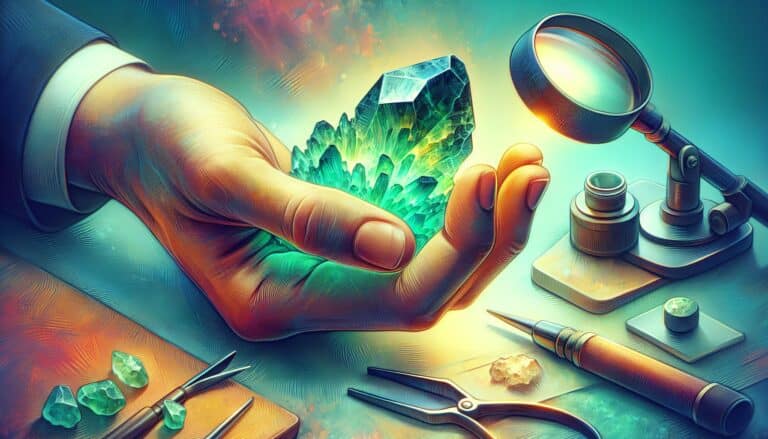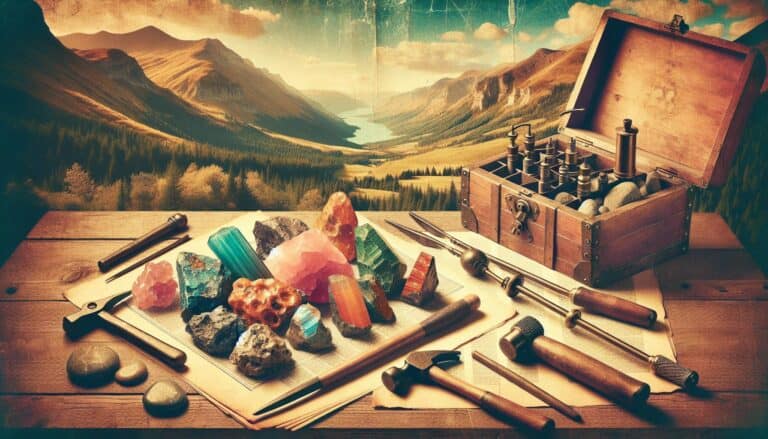Moonstone, with its ethereal glow reminiscent of moonlight, has captured hearts for centuries.
You’re probably drawn to its unique shimmer, known as adularescence, but how can you be sure you’ve got the real deal? Identifying genuine moonstone is key to ensuring your jewelry or collection features authentic, quality pieces.
Knowing what to look for is essential, from its distinctive sheen to the subtleties of its appearance. With a few expert tips, you’ll be spotting authentic moonstone like a pro.
Let’s dive into the characteristics that set genuine moonstone apart, so you can make informed choices about your next moonstone treasure.
To identify genuine moonstone, observe its unique adularescence, a moonlight-like sheen. It’s typically colorless to white, blue, or peach, with a Mohs hardness of 6.0-6.5. Authentic moonstone is not magnetic, shows translucency, and exhibits double refraction. Its specific gravity ranges from 2.56 to 2.59.
How to Identify Moonstone Through Testing
When you’re hunting for authentic moonstone, it’s crucial to understand the various testing methods available. By knowing how to properly examine a moonstone, you can make an educated guess about its authenticity. Let’s dive into the specifics.
Visual Inspection
Start with the basics: visually inspect the moonstone. Look for the hallmark sheen called adularescence. It’s the play of light you’ve read about; it should resemble a billowy light that seems to hover within the stone. Check for imperfections as moonstones are natural and may exhibit slight inclusions.
The Streak Test
Use an unglazed porcelain tile to gently rub the moonstone across the surface. Genuine moonstone should leave a white streak. If you notice any other color, it’s likely not an authentic piece.
Magnet Test
Moonstones are not magnetic. If you place a magnet near your stone and it’s attracted to the magnet, this is a clear sign the stone is not a genuine moonstone but possibly a synthetic or different mineral altogether.
Hardness Test
Moonstone falls between 6.0 and 6.5 on the Mohs scale. A simple way to test this is by attempting to scratch your stone with a steel file. If the file scratches the stone, it’s likely genuine moonstone as harder minerals won’t be as easily marked.
Birefringence Test
Observe the stone under a polariscope. Moonstone exhibits birefringence due to its layered structure. You’ll notice a double image when viewing through the scope, indicating its authentic nature.
Checking The Diaphaneity
Examining how light passes through the moonstone can be telling. Moonstones should be translucent to semi-transparent. If it’s too opaque or perfectly clear, you may want to question its authenticity.
Single or Double Refraction
Authentic moonstone is an orthoclase feldspar exhibiting double refraction. When you look through the stone, you should see two rays of light or a double image. If not, the gemstone may not be a true moonstone.
Refractive Index Test
Using a refractometer, you can measure the moonstone’s refractive index, which should range between 1.520-1.530. Numbers outside this range suggest the stone isn’t an authentic moonstone.
Finding The Specific Gravity
The specific gravity of a moonstone typically ranges from 2.56 to 2.59. You can measure this by weighing the stone in air and then in water. The specific gravity is calculated by dividing the weight in air by the loss of weight in water.
Identifying Moonstones in the Field
When you’re looking for moonstones in the field, familiarize yourself with their typical environments. Moonstones are often found in plagioclase feldspar deposits. They usually have a pearly and opalescent luster and a white to blue-white sheen.
Recognizing Potential Moonstone Rocks
In their raw form, potential moonstone rocks often have a characteristic look – they may be somewhat translucent, with a white to blue-white sheen that distinguishes them from other rocks. Look for the telltale shimmer which indicates a potential moonstone.
Remember, these tests are best used in combination to confidently identify a real moonstone. Equip yourself with these expert tips and enhance your ability to distinguish true moonstone from imitations.
Physical Characteristics of Moonstone
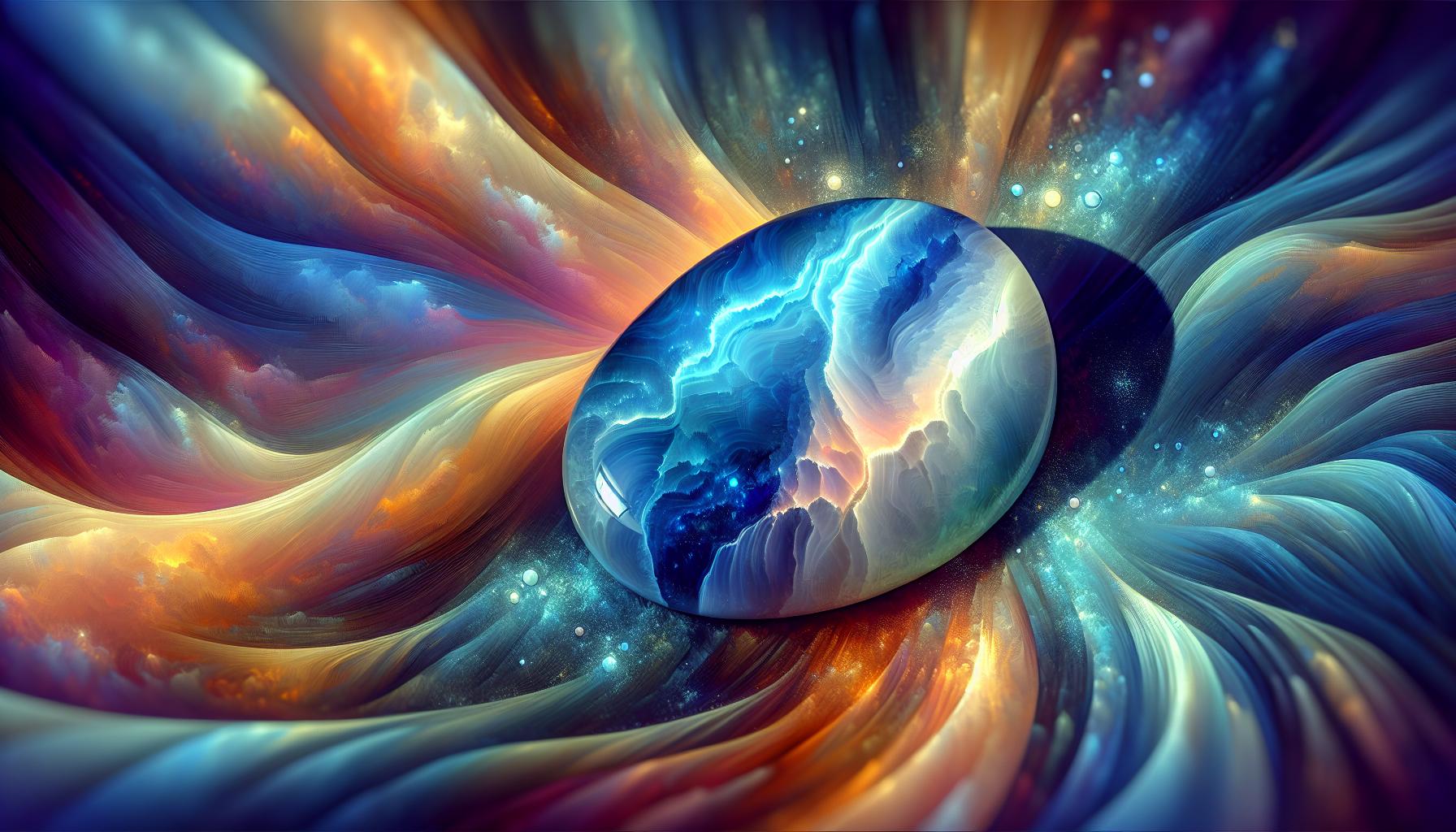
When you’re on the hunt for genuine moonstone, recognizing its distinctive physical features is key. Moonstone belongs to the feldspar group and typically exhibits a pellucid or opaque appearance. What sets moonstones apart is their unique adularescence—a mesmerizing, milky sheen that seems to float on the stone’s surface when light hits it.
The color palette of moonstone can range from colorless to gray, brown, yellow, green, or pink, but the most prized samples often show a blue or rainbow-like sheen. In terms of texture, you’re likely to find moonstones with a smooth and polished surface, which enhances their visual allure.
To ensure you’re on the right track, keep in mind that moonstones are typically cut in a cabochon shape to best display their adularescence. This means the stones are polished and shaped into a convex form, without any facets. The top of the stone is rounded to catch light effectively, while the bottom remains flat, lending to its classic appearance.
A common trait that might catch your eye is moonstone’s cleavage. It refers to the way a mineral breaks along specific planes and in the case of moonstone, it has a unique monoclinic cleavage, creating parallel surfaces. Remember, genuine moonstones have a hardness of 6 to 6.5 on the Mohs scale, which you learned about in the testing methods.
By recognizing these distinctive characteristics, you’re well-equipped to differentiate authentic moonstones from imitations in the market. Keep an eye out for the interplay of light and color, the stone’s cut, and its textural feel.
How Are Moonstone Formed?
Moonstones owe their formation to a fascinating geological process that begins deep within the Earth. These stones develop from two varieties of feldspar minerals—orthoclase and albite—which layer together as they cool slowly over millions of years. Changes in temperature and pressure cause the two minerals to separate into stacked, alternating layers. It’s this unique structure that scatters light and causes the characteristic glow, known as adularescence.
During formation, mineral intergrowth is critical as it impacts the appearance of the moonstone. The thinner these layers are, the more pronounced the adularescence effect becomes. As moonstones near the Earth’s surface, external factors like water can alter their composition and enhance their luster. Interestingly, the finest quality moonstones are typically found in regions with a history of volcanic activity.
Geological locations play a vital role in moonstone development, with notable sources in countries like Sri Lanka, India, and Madagascar. Each location often produces moonstones with distinctive qualities, like the blue sheen found in specimens from Sri Lanka.
By understanding their geological makeup, you can better appreciate the value of the moonstones you encounter and make informed decisions when selecting a stone that meets your criteria. Remember, moonstone’s beauty lies in its creation—a slow transformation from the raw to the mystical.
Preparation for Moonstone Hunting
Before you begin your search for the elusive and enchanting moonstone, ensure that you have everything you need. Proper preparation will maximize your chances of finding high-quality specimens and ensuring a safe and productive trip.
Gathering the Right Tools
To effectively hunt for moonstones, you’ll need to assemble a set of tools designed for geological exploration. Here’s a list you should consider:
- Geologist’s hammer: Essential for breaking rocks to reveal potential moonstones.
- Chisel: Aids in prying apart layers of rock and targeting specific areas.
- Hard-wearing gloves: Protect your hands from sharp edges and rough surfaces.
- Durable backpack: Should hold all your tools and collected samples securely.
- Protective eyewear: To safeguard your eyes from flying rock chips.
Besides these tools, consider bringing a magnifying glass to examine specimens on the spot. It can help you determine if you’ve found a moonstone or another mineral. A portable light can also be useful, particularly if you find yourself in shaded areas or as daylight wanes.
Safety Considerations
While the thrill of discovery can be exhilarating, your safety should always be a top priority. Keep the following in mind:
- Wear a helmet to protect your head from any accidental rock falls or bumps.
- Dress in protective clothing, including long sleeves and pants, to minimize scratches and cuts.
- Ensure you have a first-aid kit for any minor injuries.
- Study the area you’ll be exploring; understand the terrain and potential hazards like wildlife or unstable ground.
- Bring sufficient water and snacks to stay hydrated and energized.
- Inform someone about your whereabouts and expected return time.
Remember, the erratic nature of moonstone formation means they could turn up where you least expect them. However, it’s typically more productive to search in regions known for volcanic activity and existing feldspar deposits. Your prior knowledge of the geological makeup of moonstones will be an invaluable guide in identifying likely spots to begin your search.
Despite your preparations, remember that moonstone hunting can be hit or miss. Each outing is an opportunity to learn and hone your identification skills. Keep an open mind, stay persistent, and enjoy the adventure that comes with hunting for these natural treasures.
Handling and Care of Found Moonstone
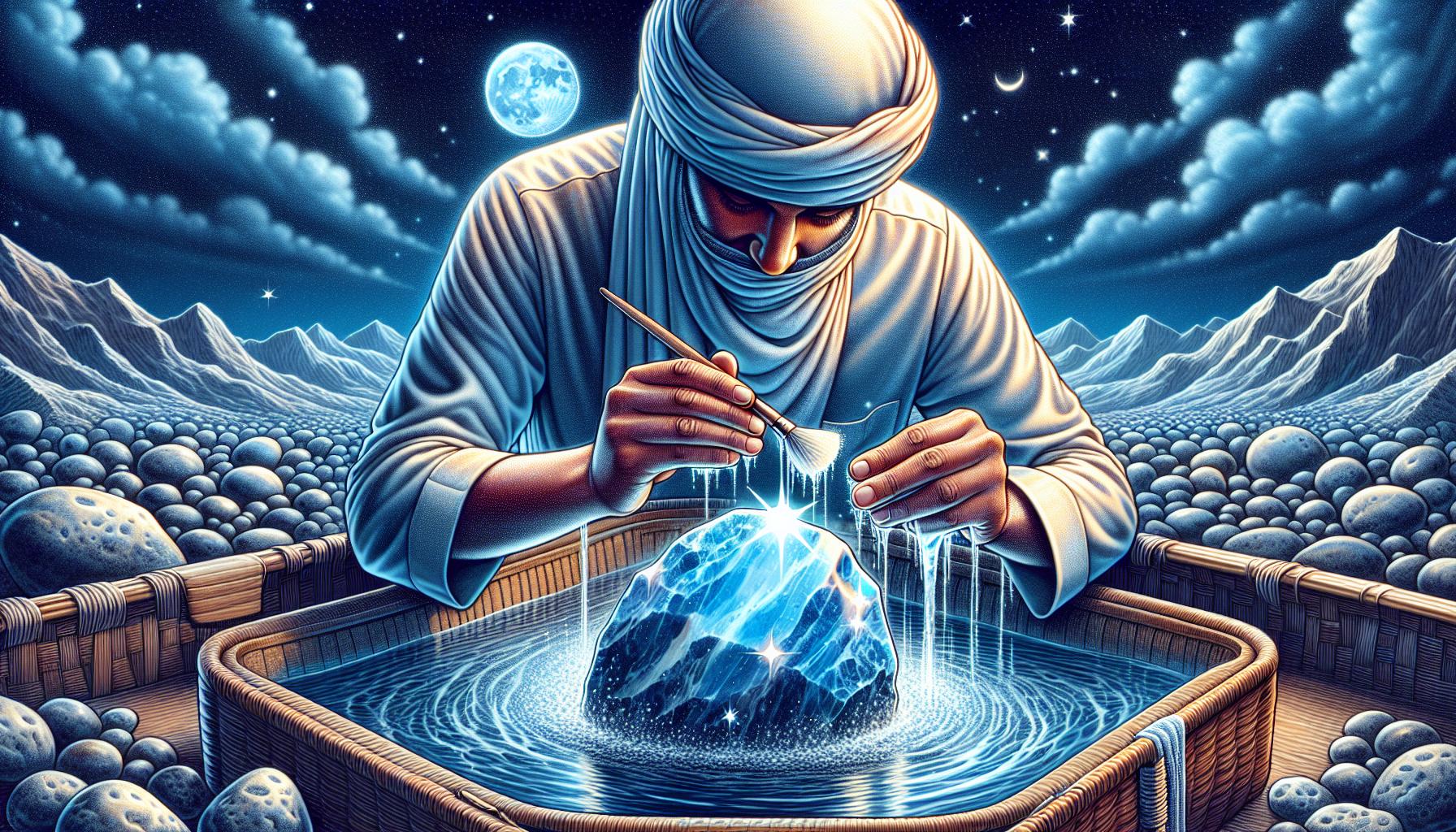
Cleaning Moonstones
Once you’ve had a successful hunt and are in possession of raw moonstones, proper cleaning is crucial. Start by gently rinsing your moonstones in lukewarm water. You’ll want to remove any dirt or debris without being too abrasive. Use a soft-bristled brush, like a toothbrush, for stubborn grime. Be sure to avoid harsh chemicals or ultrasonic cleaners; these can damage the moonstone’s delicate structure.
When drying moonstones, opt for a soft, lint-free cloth. Pat them dry rather than rubbing, to reduce the risk of scratches. It’s also wise to clean moonstones one at a time to prevent them from knocking against each other, which could cause chipping or fracturing.
Storing Moonstones
Proper storage is as essential as cleaning. Moonstones are relatively delicate with a Mohs hardness rating of 6.0-6.5, meaning they can easily be scratched by harder materials. Here’s how to store them safely:
- Wrap each moonstone individually in a soft cloth or place it in a fabric-lined box to prevent scratches.
- Keep moonstones away from direct sunlight and high temperatures to avoid discoloration or cracking.
- Store your moonstones in a dry environment to prevent long-term exposure to moisture, which could damage their luster.
By taking these steps, you’ll ensure your moonstones remain in pristine condition, retaining their beguiling sheen and the mysterious adularescence that makes them so coveted. Remember, the way you care for your moonstones directly impacts their beauty and durability.
Conclusion: Confirming Moonstone is Real
You’ve now got the know-how to identify a genuine moonstone and understand the importance of handling and caring for your gem with the utmost attention.
Remember to gently clean your moonstone with lukewarm water and a soft brush and to avoid harsh chemicals that could damage its luster. Proper storage is key—wrap your stone carefully or place it in a fabric-lined box away from the harsh elements. With these tips in mind, you’ll ensure your moonstone retains its mystical allure for years to come.
Keep cherishing its unique beauty and enjoy the subtle play of light that makes your moonstone so captivating.


